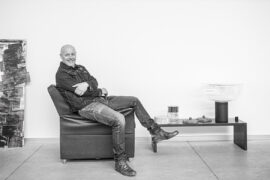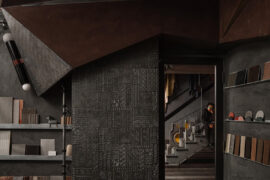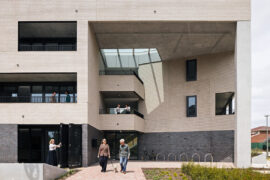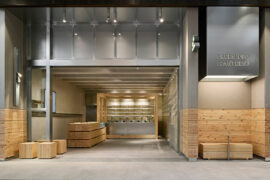The design at Fotografiska Shanghai honours the industrial legacy of the building, forming an authentic, multi-layered environment for photography exhibitions.

October 9th, 2024
Flanked along Suzhou Creek in Shanghai, a former bank warehouse has been remodelled by AIM Architecture into a museum, that goes by the name Fotografiska Shanghai. This museum is a poetic immersion into the realm of visual narratives, woven through the lens of photography. Beyond exhibitions, it will host workshops, lectures and events, fostering a community of artists, enthusiasts and curious minds who share a passion for photography.

The design at Fotografiska Shanghai honours the industrial legacy of the building by integrating original brickwork, concrete beams and industrial details into modern spaces, forming a multi-layered environment rich with authenticity. The centre stands as an architectural embodiment of AIM Architecture’s commitment to preserving the past while reinventing the future. Fotografiska Shanghai acts as a catalyst for neighbourhood revival, metamorphosing a dormant space into a vibrant cultural hub.
The first-floor layout, inspired by Shanghai’s diverse layers, comprises openness and fluidity. Various functions coalesce, offering a sequence of moments organised to facilitate human interaction. The restaurant, bar, retail space and ice cream shop meld legacy with modernity, offering an experience that merges historical richness with a contemporary twist.
Related: The story of AIM Architecture

Circulation within the museum unfolds through two grand staircases, echoing the building’s industrial past and subtly nodding to the origins of photography. These respective staircases act as the spine of the building, with custom-designed vertical lights along the walls guiding visitors through the exhibits. The light display guides guests from the former space to the latter, creating an interplay of light and movement. Each space etched on the floorplan is lacquered in the curated colours of Fotografiska. Despite the absence of natural light, deliberate ceiling spots accentuate photographs, while concrete walls preserve industrial authenticity. Transition spaces between exhibition areas serve as moments to reconnect with the building, with minimal interventions that focus on essentials.
The topmost floor presents a futuristic vision of the traditional garden room, mystifying the border between indoor and outdoor spaces, where visitors can access a vast terrace with panoramic views, featuring a bar, lounge, exclusive VIP room and sunken seating. The venue evokes a retro charm, embodied in green and yellow tones and textures, that transports visitors through time.
AIM Architecture
aim-architecture.com

INDESIGN is on instagram
Follow @indesignlive
A searchable and comprehensive guide for specifying leading products and their suppliers
Keep up to date with the latest and greatest from our industry BFF's!

Merging two hotel identities in one landmark development, Hotel Indigo and Holiday Inn Little Collins capture the spirit of Melbourne through Buchan’s narrative-driven design – elevated by GROHE’s signature craftsmanship.

For a closer look behind the creative process, watch this video interview with Sebastian Nash, where he explores the making of King Living’s textile range – from fibre choices to design intent.

We caught up with Abramo Manfrotto, CEO of Venetian decorative lighting brand LEUCOS, during a visit to Australia with dedece.

Bangalore studio Multitude of Sins elevates true leftovers — not surplus — into a richly layered workspace where waste materials become narrative, structure and sculptural expression.
The internet never sleeps! Here's the stuff you might have missed

Brett Ward, General Manager of Marketing at Brickworks, tells us how modern approaches to sustainability are intersecting with the long history of the brick.

Hecker Guthrie brings a natural, material-led design to Green Cup’s new Chadstone store, pairing pine, steel and glass with a grab-and-go layout inspired by the brand’s fresh, organic ethos.